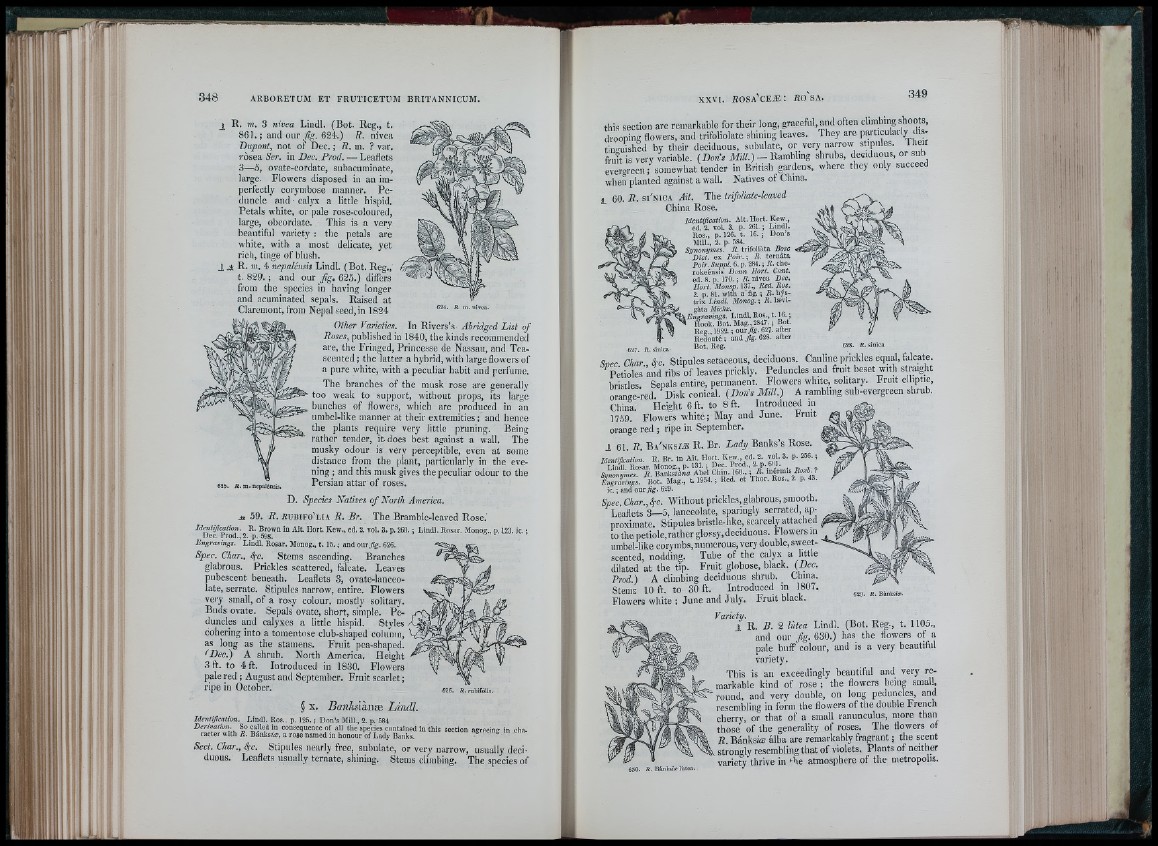
ir f
I ;
m
!i3 î
i
R. VI. 3 nivea Lindl. (Bot. Reg., t.
86 1 .; and our 624.) R. nivea
Dupont, not of Dec. ; /?, m. ? var.
ròsea Ser. in Dec.. Prod. — Leaflets
3—5, ovate-cordate, subacuminate,
large. Flowers disposed in an imperfectly
corymbose manner. P e duncle
and • calyx a little hispid.
Petals white, or pale rose-coloured,
large, obcordate. This is a very
beautiful variety : the petals are
white, with a most deli
flicate, yet
rich, tinge of blush.
1 ^ R. Vi. 4 nepalénsis Lindl. (Bot. Reg.,
t. 823. ; and o u r / g . 625.) differs
from the species in having longer
and acuminated sepais. Raised at
Claremont, from Nepal seed, in 1824
Other Varieties.
In Rivers’s Abridged List of
Roses, published in 1840, the kinds recommended
are, the Fringed, Princesse de Nassau, and Tea-
scented ; the latter a hybrid, with large flowers of
a pure white, v/ith a peculiar habit and perfume.
The branches of the musk rose are generally
too weak to supjiort, without props, its large
bunches of flowers, which are produced in an
umbeUlike manner at their extremities; and hence
the plants require very little pruning. Being
rather tender, i t does best against a wall. The
musky odour is very perceptible, even a t some
distance from the plant, particularly in the even
in g ; and this musk gives the peculiar odour to the
Persian attar of roses.
D. Species Natives of North America.
59. R. r u b i f o ' l i a R. Br. The Bramble-leaved Rose.'
Idm hyicatton.^ R. Brown in AiL Hort. Kew., ed. 2. vol. 3. p. 260.; Lindl. Kosar, Monog., p. 123. i c . ;
Engravings. Lindl. Rosar. Monog., t. 1.5.; and our fig . C26.
Spec. Char., Stems ascending. Branches
glabrous. Prickles scattered, falcate. Leaves
pubescent beneath. Leaflets 3, ovate-lanceolate,
serrate. Stipules narrow, entire. Flowers
very small, o f a rosy colour, mostly solitary.
Buds ovate. Sepals ovate, short, simple. P e duncles
and calyxes a little hispid. Styles -
cohering into a tomentose club-shaped column,
as long as the stamens. F ruit pea-shaped.
^Dec.) A shrub. North America. Height
3 ft. to 4 ft. Introduced in 1830. Flowers
pale red ; August and September. F ruit scarlet;
ripe in October. ggg. ^bifoiia.
§ X . Bun/isihise Lindl.
Identification. Lindl. Ros., p. 125. ? Do n ’s Mill., 2. p. .584
-------------- „ .. .. species coi_______
Derivation, feta Mlled in consequence of all tho species contained in this section agreeing in cha-
ii R . Banks?«e, a rose named in honour r o f Lady Banks.
Sect. Char., f r . Stipules nearly free, subulate, or very narrow, usually deciduous.
Leaflets usually ternate, shining. Stems climbing. Tlie species of
this section are remarkable for their long, graceful, a f t often climbing shoots,
drooping flowers, and trifoliolate shining leaves. T hey are particularly fts -
tinnuished by their deciduous, subulate, or very narrow stipules. Theii
f t a t is very variable. (Bonk MiU.) - Rambling shrubs, c ftiduous, or sub
evergreen; somewhat\ender in British gardens, where they only succeed
when planted against a wall. Natives of China.
t 60. R. s i ' n i c a Ait. The trifoliate-leaved
China Rose.
Identification. Ait. H o rt. Kew.,
ed. 2. vol. 3. p. 2G1. j Lindl.
Ros., p. 126. t. 16. ; D o n ’s
Mill., 2. p. 584.
Sunonvmes. R. trifoliàta Bosc
Diet, ex P o ir.', R . te rn à ta
Poir. Suppl. 6. p. 284. ; R . che-
rokeénsis Donn Hort. Cant.
ed. 8. p. 170. ; R. nivea Dec.
Hort. Monsp. 137., Red. Ros.
2. p. 81. with a'fig. ; R . hys-
trix Lindl. Monog. ; R . lævigàta
Michx.
Eneravings. Lindl. Ros., 1 .16. ;
1 H o o k . Bot. Mag., 2847. ; Bot.
Reg., 1922. ; o u r 627. after
Redouté ; and fig . 628. after
627. R. s ín ica Bot. Reg.
Sner Char f r . Stipules setaceous, deciduous. Cauline prickles equal, falcate,
t e t r ’and ribs "of leaves prickly. Peduncles and fruit beset w.th s tr a .f tt
bristles. Sepals entire, permanent. Flowers white, solitary. F ruit elliptic,
orange-red. Disk conical. (Boti’s M ill.) A rambling sub-evergreen shrub.
China. Height 6 ft. to 8 ft. Introduced in
1759. Flowers w h ite ; May and June. F ru it
orange red ; ripe in September.
1 61. R. B a ' n k s / æ R. Br. Lady Banks’s Rose.
Idcntijwation. K. Br. in Ait. Hort. Kew., ed 2. vol. 3. p. 256. ;
ic. ; and om fig . 6¿9.
Spec. Char., 4c. Without prickles, glabrous, smooth.
Leaflets 3—5, lanceolate, sparingly serrated, approximate.
Stipules bristle-hke, scarcely attached
to the petiole, rather glossy, deciduous. Flowers m
umbel-like corymbs, numerous, very double, sweet-
scented, nodding. Tube of the calyx a little
dilated at the tip. F ru it globose, black. (Bee.
Prod.) A climbing deciduous shrub. Chma.
Stems 10 ft. to 30 ft. Introduced in 1807.
Flowers white ; June and July. Fruit black. 6 29. R . Binksiee.
630. R . B á n k s í« lù te a .
Variety.
1 R. ri. 2 liitea Lindl. (Bot. Reg., t. 1105.,
and our fig. 630.) has the flowers of a
pale buff colour, and is a very beautiful
variety.
This is an exceedingly beautiful and very remarkable
kind of rose ; the flowers being small,
round, and very double, on long peduncles, and
resembling in form the flowers of the double French
cherry, or th a t of a small ranunculus, more than
those of the generality of roses. The flowers of
R. B anksà» alba are remarkably fragrant ; the scent
strongly resembling tha t o f violets. Plants of neither
variety thrive in *he atmosphere of the metropolis.